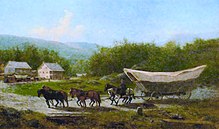Conestoga (wagon)

The Conestoga Wagon (Eng. Conestoga-Wagen) was a heavy truck pulled by four to six horses, which was built by the German emigrants in Pennsylvania at the time of the colonial days in the USA . It is definitely documented for the first time in 1754. It should not be confused with the classic covered wagon , the " Prairie Schooner ", which is known from numerous westerns . This one was built much lighter.
The Conestoga wagon was used for freight transport in the eastern United States. It was an ingenious construction. A typical feature is the raised car floor at the front and rear. The purpose of this was to prevent the cargo from slipping when driving up and downhill in the mountainous region. The car was very high-wheeled in order to be able to pass through smaller streams and rivers without the cargo getting wet. In addition, the wagon floor was caulked ( sealed with tow and pitch ). The very large ground clearance was also necessary in order to be able to drive over tree stumps and boulders, since the “roads” at the time were more like paths and unkempt field and forest paths. It also had four-inch-wide wheels to keep it from sinking too deeply. The loading capacity was a good five metric tons .
The “ Conestoga Wagon ” was the first car of its time to have a brake that acted on the rear wheels. It was operated with a long lever on the left side of the car. There was also the " lazy board ", a solid oak board that could be pulled out and on which the driver (or his assistant) could sit. Most of the time, however, the driver walked next to the car, or he rode the " wheel horse ", the left horse directly in front of the car.
The colors of the cars followed the tradition of the German settlers in Pennsylvania: bright, light blue car body, red wheels and running gear, white canopy made of canvas or house-woven canvas.
The wagons were pulled by relatively heavy horses of a special breed, the " Conestoga Horses ". They were 1.70 to 1.80 meters tall and weighed about 1,800 pounds (approx. 820 kg). Originally it was black horses, which probably went back to the black English draft horses. Later dark browns and grays also appeared (through crossing into other races). On the horse's collar there was a bow with small iron or bronze bells hanging from it; the front team had five, the middle four and the last three. From afar you could hear the tinkling of bells of different sizes - and see that you were getting yourself, the children and the cattle out of the way. The bells were the pride and joy of the drivers. It was considered a shame to arrive without it (e.g. because you had to leave it to another driver who had dragged you out of the quagmire). This is where the saying goes “ I will be there with bells on .” (“Everything will go well.”)
The coachmen were also a special hit. The professional truck drivers ("regulars") were tough guys. They mostly wore red flannel shirts, drill or lederhosen, leather boots and wide-brimmed felt hats. They were constantly smoking a special kind of cheap cigars against the dust and were constantly on the move. They are also said to have been very hard-drinking. And they loved dancing and playing cards. They had to be able to take off the wheels to grease the axles, shod the horses, use an ax to clear the path of fallen trees, and make minor repairs. They carried the necessary tools with them on the cart.
They drove as long as it was light, stayed overnight with their team at the car or, if the weather was fine, drove to the nearest inn. Often they were in whole columns of up to 100 cars. The average daily distance was 15 miles (about 24 km).
There were three main routes they traveled on:
- Across the Appalachian Mountains to Pittsburgh, where the cargo was reloaded onto ships and transported down into the Ohio Valley; - on the " National Road " connecting Baltimore and Frederic in Maryland to Wheeling West in Virginia; - and finally around 1852 to Vandalia in Illinois and the " Great Wagon Road " through the Virginia Valley to North Carolina.
In addition, there were occasional drivers (" sharpshooters "), mostly farmers, who drove their trailers when the freight rates were high and there was additional money to be made.
history
The Germans who settled near the Conestoga Indians in 1751 initially named their settlement Conestoga. The city was later renamed Lancaster . They developed the Conestoga Wagon from the farm wagons known from Germany and England. Until the advent of the railroad, it was the predominant means of transporting goods. The first known mention of a "Conestoga Wagon" comes from James Logan in his accounting diary of December 31, 1717, after he had bought the car from James Hendricks. The resulting, lighter Prairie Schooner, which was also pulled by mules or oxen, later contributed significantly to the colonization of the western parts of North America.
Individual evidence
- ↑ Conestoga Wagon Historical Marker accessed July 25, 2016.
- ^ The Prairie Schooner Got Them There ( September 26, 2010 memento on the Internet Archive ), article in American Heritage


